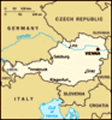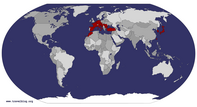Advertisement

 Hofburg
Hofburg
The Hapsburg EstateOur next stop was Vienna, home to the Viennese. I almost completely missed the city because the map I was using refers to this city as Wien. German is the local language here, and I believe the name Wien comes from this. So in German, this is Wien, home to the Wieners. It wasn’t until I looked at another map that I saw the name Vienna instead, and I am very glad I did so. Vienna is a great city. Its not too big, but not too small, and has some exquisite buildings, cathedrals, and estates. Travis sat next to a woman named Roxanne on the bus from Prague, and when we arrived she offered to show us through the city to our hostel since it was on her way. During our walk we came upon Stadtpark. Stadtpark happened to be hosting an event called Guness. There were many tents lining the path, each tent showing and selling either juice, wine, cheese, meat, chocolate, whiskey, and many other things of that nature. Many of the juice and cheese tents were distributing free samples as well. We stayed at the Hostel Ruthensteiner, by the West Banhof train station on the west side

 Town Hall
Town Hall
View from Hofburgof the city. Complete with a bar on the main level, and instruments hanging from the walls for guest use, this place had a lot of character.
We spent the next day wandering around the center of the city. Every street we went down had a building at least 300 years old. We started out walking through a lawn between the Natural History Museum, and another building known as the Kunst History Museum. These buildings faced each other and were almost identical. Continuing the through the lawn and across the street, we were led right into the center of the Hofburg, the estate of the Hapsburgs. This was not just one, but several interconnected buildings with lawns and courtyards in between. Two giant statues of horsemen faced each other in the main lawn. The estate was now home to museums, a Spanish riding school, and more. The estate was covered in statues, each wall was decorated with carved stone, and even the hallways between courtyards were decorated from top to bottom. Many horse-drawn carriages were being pulled throughout this area, as well as the rest of the center of the city as we’d come to find out.
We
had a literature guide which pointed out some key sights in the city and had a paragraph describing each sight. It started with the State Opera House, which holds operas just about every night. Apparently the building design took some heavy criticism upon its unveiling. So much so, in fact, that one of its architects committed suicide shortly after. From there we were led through monuments and palaces until we came to the Dorotheum. The Dorotheum was a marketplace for the aristocracy to sell their belongings during times of poverty. I think they went baroque. We could see spires from the Town Hall from distance, and we finally arrived in front of it. The front walkway to the Town Hall had a garden on either side complete with ponds and fountains. Back towards the center of the city we came upon the Church of the Minorities, which looked ironically pale in the sunlight. Back by the Hofburg was Michealsplatz, home to St. Michael’s Cathedral and the Roos Haus. The front of the Roos Haus was decorated with large marble pillars. The marble used was a darker green, and at the time many found it disgusting and compared it to “sewer

 Mozart
Mozart
Notice the Treble Clef in the lawnlines”. In the middle of Michaelsplatz was an excavation. Some ancient Roman ruins were being revealed. Whoever was digging had apparently just started, and only a few brick walls could be seen.
From there we walk through one of the two main boardwalks in the city center, Graben. This broad street had many shops and restaurants lining it, and had a few statues in the middle. A tall, almost obelisque, Plague Column was displayed in the middle. This statue was erected as a monument to God for saving the people from the plague. The column displayed white clouds stacked on top of each other with saints posing in worship. A church of St. Peter could be seen just to the East of the Plague Column, which used to be nothing more than a wooden chapel. A few steps forward came the intersection of the two main boardwalks in the city, and the intersection was known as Stock-im-Eisen. Many people gathered around as a marionette danced around, sang, and played piano. Other people lined up to take their picture with a mime or a man dressed up as a statue. Yes, a statue. This wasn’t the first city where I’ve
seen these guys, so apparently its quite popular. These guys dress up in all silver, gold, white, or pale green, complete with gloves, hats, and face-paint. Most of them have a small stand to stand on where they will wait still as can be for someone to approach them. Around the corner from this crowded square was Stephansplatz and Stephen’s Cathedral. The Cathedral did not span much area, but was much taller than the other buildings around it. The inside was very large and with intricate design, but reminded me a lot of the other cathedral’s I had seen along the way. We left the city center down Karntnerstrauss, the other large boulevard which was also lined with shops and restaurants.
That evening we randomly ran into Terry, a friend of Belle’s, whom we met in Paris. She happened to be staying at the same hostel we were staying at in Vienna. It really is a small world. We hung around at the hostel bar that night talking with Terry and some of the other travelers there. Some were playing guitar while others sang. I found myself talking to an older gentleman who had first traveled Europe in the
50’s, and after retiring had explored a different area of Europe every year. While many people along the way had tried to discourage us from going farther east, this man was offering nothing but encouragement. When asked, I told him I never felt like anyone disliked me simply because I was American, and that I felt most people offered the same respect I gave them. He said with that attitude I should be just fine anywhere, and I think that makes a lot of sense. Most people who think they hate America, probably just hate the government. These days, most people realize the separation between a people and their government. After all, it’s not me making the decisions, and the government rarely asks my opinion. Anyway, with that I found new inspiration for traveling deeper into Europe.
After a relaxing morning we headed towards St. Charles Church and Belvedere Garden. The Belvedere Estate enclosed a large garden which led up to a broad palace. From the top of the garden, near the palace, the center of Vienna could be seen. During the exploration from the previous day we noticed much of the city was under repair, and this view
was confirmation. About 7 cranes stood out taller than many of the buildings and disrupted the view of the city a little. We walked to St. Charles Church in time to see a free concert shown right in front. There we met with Jelena, a friend I first met in DC through Sachin, her roommate in college and my colleague. Jelena introduced us to some friends who had a place picked out on the lawn to watch the concert. As night fell colored lights were cast upon the front of the church. The stage was positioned in between the crowd and the church, and the church became the backdrop. What a show. The band played a mix of folk and blues. The lead guitarist and singer wore a hat that made him remind me of Tom Petty.
Our last day we went to explore one more palace before our bus left for Budapest, the Schonbrunn Palace. My first impression was that this palace was going to be exactly like the Belvedere Palace, but as I walked through I realized this palace put the Belvedere to shame. The Palace was not only broad, but equally deep with a courtyard in

 St. Charles Church
St. Charles Church
Nice concert backdropthe center. Walking through the courtyard we were led through an outdoor hall and around to the garden. The “backyard” of this palace was a maze of perfectly manicured trees, bushes, gardens. Many of its statues, fountains, and other features couldn’t even be seen through the tall maze of trees. The backyard sloped upward to a large gate dedicated to Maria Theresa, and was one of the highest points in Vienna. I first walked straight to this gate and went to the very top where I could see all of Vienna. This gave me not only a better view of the city center than at the Belvedere garden, but gave a full 360 view of the other parts of Vienna. On the west side, and still within the estate, were the imperial zoo and two large greenhouses. On the east side was a public pool. However, even from the top of this Gate, at the highest point on the estate, these features could not be seen through the immense maze of trees. Wandering through green hallway after green hallway we finally came across the greenhouses. Though no information was displayed, the small size of its windows gave good hints as

 Schonbrunn
Schonbrunn
View from the top of Maria Theresa Gateto how old they were. After exploring many nooks and crannies in this maze, we finally decided we had seen just about everything on this estate.
We’ve been hearing many good things about Budapest, and have been seeing pamphlets for it as far back as Berlin. I hope it lives up to its potential!
Advertisement
Tot: 0.097s; Tpl: 0.014s; cc: 14; qc: 71; dbt: 0.0598s; 1; m:domysql w:travelblog (10.17.0.13); sld: 1;
; mem: 1.2mb











DAD325
non-member comment
Local products
Did you find any sausages or fingers there?